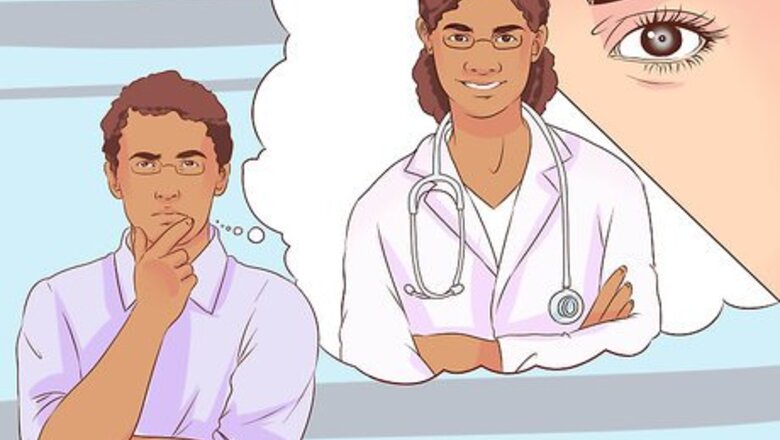
views
Preparing for Your Appointment
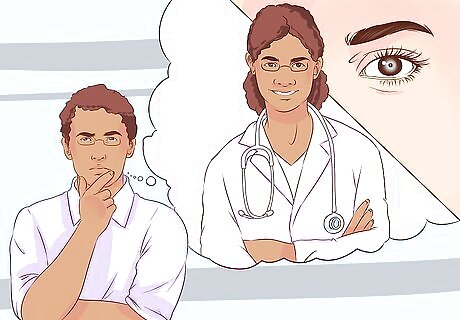
Decide what kind of doctor you need. There are three kinds of eye specialists who can perform an eye exam. They have different specialties, and the kind you look for will depend on what kind of problem you have and your personal preference. Ophthalmologists. These are medical doctors who can provide the full range of eye care. They give eye exams and prescribe corrective lenses. They can also diagnose and treat eye diseases, and perform eye surgery. Optometrists. These can provide many of the same services as ophthalmologists, including exams, prescriptions, and even treating certain diseases. If you have a more serious problem, or require surgery, they will probably refer you to an ophthalmologist. Opticians. These are focused on filling prescriptions for eyeglasses and occasionally contact lenses. They will provide basic eye exams for the purpose of figuring out your needs, but won’t be able to give medical treatment.
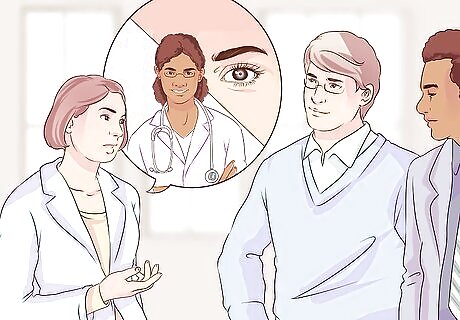
Find an eye doctor. Your eye doctor is going to be different than your regular doctor, and you may not immediately know of one. If you want to get your eyes checked, there are several good sources for finding an eye doctor to call. Get a referral from someone you trust. This can be friends or family who have gone to an eye doctor that they like, or you can ask your personal doctor. If you are near a hospital or university medical center, call the department of ophthalmology or optometry to get information. You can also look for state and county academies, associations, or societies of optometrists and ophthalmologists for more help. Ask your insurance company, especially if there are any covered under your plan. Your options may be more limited here, but you will likely find one that your plan pays for, which can reduce the cost of your visit.

Make an appointment. In most cases, you can’t just show up to an eye doctor and expect to get an exam. Once you have a doctor to visit, give the office a call so you can set up an appointment. When you call the office to set up an appointment, the receptionist will ask why you are visiting. You can give any answer you want, even saying you just want a check-up, as long as the doctor knows what to expect when you arrive. Some specific problems you might have that an eye doctor should look at include red or painful eyes, foreign bodies in your eyes, reduced vision, double vision, or headaches. Your answer here will help the doctor prepare for your visit. If you are having problems, this is the time to explain them, so the doctor will know what to look for when you arrive. Once you set up an appointment, it is important that you arrive on time. Eye doctors are busy, and if you are late they will probably take someone else, meaning you’ll have to wait, or even reschedule for another time. Your best bet is arrive a few minutes before your appointment, so you are ready and waiting when the doctor calls you in.

Prepare for the doctor’s questions. When you are at the doctor’s office, there are certain questions he will be sure to ask. It can be helpful, and make your appointment go more quickly, to make sure you know the answers to these questions before you go. Topics you will discuss include: Eye problems you are currently having. You’ll talk about any pain or discomfort you feel, maybe under different lighting conditions, if your vision gets blurry at certain distances, or if you are having problems with your side vision. Your history of eye problems. Certainly you’ll talk about wearing glasses or contacts. The doctor will make sure you are wearing them regularly, especially if you need them, and if you are happy with them. You will also want to talk about if you have had other eye problems in the past. Family history of eye problems. Your doctor will want to know if someone in your family has had eye issues, including cataracts, glaucoma, or macular degeneration. Other parts of your health history. This can include being born prematurely, recent health problems such as high blood pressure or heart disease, diabetes, or if you are overweight. Your doctor will also ask similar questions about your family’s medical history. Medication history, including if you are currently taking anything or if you have any particular allergies to food or drugs.

Bring a valid ID and your insurance information. Like any other doctor’s appointment, you will need to fill out paperwork and be prepared to provide personal information. If you have health insurance, make sure you bring your card or other form of identification so that the office knows how to arrange payment.

Bring your glasses or contacts. If you wear visual aids, like glasses or contacts, make sure you bring them with you to the exam. Your doctor will want to see your prescription and the condition of your glasses. Even if you don’t need a new prescription, you may want replacement lenses or frames. If you wear sunglasses, it can be good to bring those too. It can be helpful for the doctor to see the prescription and keep them in good shape. Plus, if your eyes are dilated, they will be more sensitive to light, so you might want them on the ride home.
Getting Your Eyes Examined

Check your visual acuity. This is a common test to see how clearly you can see. The doctor will have you look at a chart with letters written on it. As you look down the chart, the letters will get smaller and harder to read. This is called a Snellen chart, and will give a good sense of how clearly you can see from a distance. Visual acuity is measured from 20 feet away. When you get a measurement on your eyesight, it will include “20” over another number, explaining your vision. For example, 20/100 means that you can see at 20 feet what a normal person can see at 100 feet. Your doctor may also test your close range acuity with a card that you hold in front of you like a book or newspaper. This card will usually be about 14 inches away from your face.
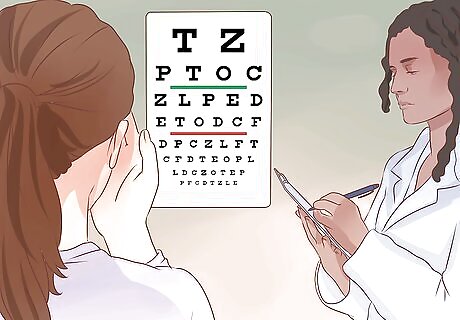
Get a refraction assessment. In this test, your doctor is looking to see that light refracts (bends) properly to the back of your eye. If the light doesn’t bend properly, that’s when you need some form of correction, usually glasses or contacts. The first part of the assessment may involve shining a light into your eye and measuring the light’s movement as it gets reflected back through your pupil. Your doctor might even have a computerized reader for this. This is meant to give an estimate of your refraction. The next step involves fine-tuning this estimate, probably using a phoropter, a mask-like device that the doctor will put in front of your face. The doctor will adjust a series of lenses, and ask you to judge which ones help you see better.

Test your eye muscles. One of the things the doctor will want to check is that your muscles can control your eyes. He will ask you to follow a small object with your eyes, usually a pen or small light, to see how well your eyes move. He will be looking for muscle weakness, poor control, or poor coordination.
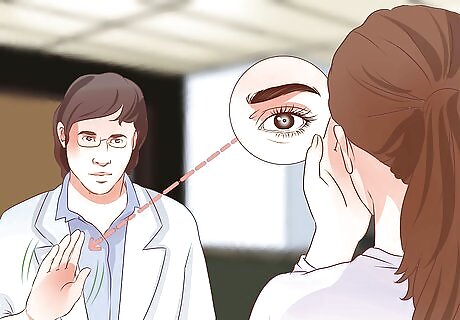
Check your visual field. This will examine your peripheral vision, that is your ability to see side-to-side without moving your eyes or head. The test will try to determine how well you can see your surroundings, and if you have trouble viewing any particular area. There are several different ways to test your field of vision. Confrontation exam. Here, your doctor will sit in front of you and have you cover one eye. He will ask you to stare straight ahead while he moves his hands around your face. You will then tell him when you are able to see his hand. Tangent screen exam. In this test, you will stare at a target on a screen. Other objects will appear on the screen while you stare straight ahead, and you will tell the doctor when you see them and when they disappear. Automated perimetry. This test involves you watching a screen with blinking lights. You will tell your doctor every time you see one. This test usually involves you staring at an enclosed screen, and pressing a button to signal that you see something.
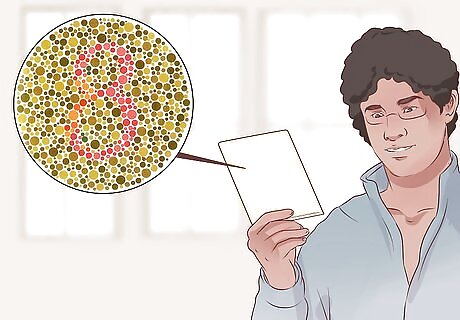
Test your color vision. If you are having trouble telling the difference between certain colors, your doctor may test to see if you are color blind. This test will involve a pattern of colored dots. There will be shapes and letters in different colors in the patterns. If you have trouble seeing colors, it will be difficult or impossible to see the shapes.
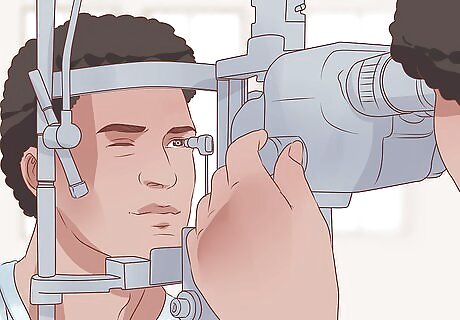
Use a slit lamp. A slit lamp is a microscope that uses an intense line of light to illuminate the front of your eye. The doctor will use this light to examine the different parts of your eye, including the lids, cornea, iris, and lens to make sure everything looks healthy. In some cases, the doctor may use dye to help color the film of tears over your eye. This dye is perfectly safe, and will wash away quickly after the doctor is done. The dye can help color in damaged cells in your eye, making them easier for the doctor to see.
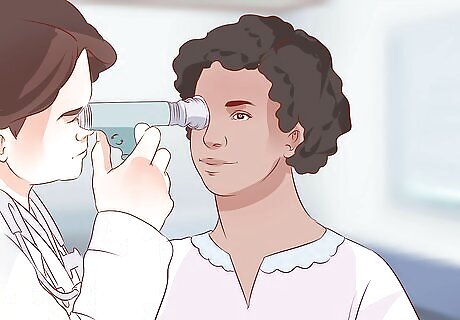
Get a retinal examination. This is sometimes called an ophthalmoscopy or funduscopy, and will allow the doctor to see the back of your eye. It is done with an ophthalmoscope, which is basically a small handheld device that the doctor will use to shine a light into your eye. To do this properly, he will need to give you drops that dilate your pupils, making them bigger. Once he has given you the drops, there are several different ways the doctor may examine your eyes. Direct exam. Here, the doctor will use an ophthalmoscope to shine a beam of light directly into your eye. Indirect exam. In this test the doctor will have a bright light mounted on his forehead, and reflect it towards your eye using a conditioning lens that he holds near your eye. You may be lying down or reclining for this test. If your pupils are dilated they will be more sensitive to light. This means you may want to bring sunglasses to help you get home, or even go with a friend so you don’t have to drive.
Following Up Your Exam
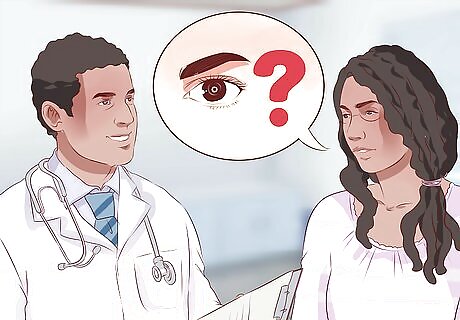
Ask any questions you have. Your doctor has probably asked you plenty of questions during the exam, and now it’s your turn. If you are unsure about anything he said, or suggestions he is making, go ahead and ask. Both of you want your eyes to be as healthy as possible, so if you need the doctor to clarify something, just ask. If you come up with questions after the exam, don’t be afraid to call the office afterward.
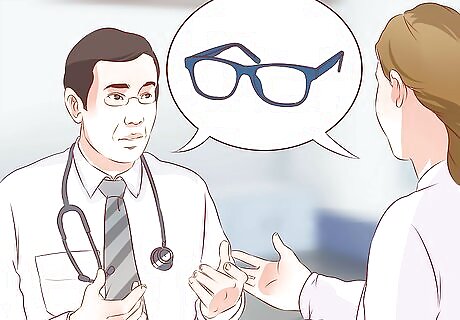
Discuss your visual aids. After giving you the exam, your doctor may decide that you need visual aids like glasses or contacts, or stronger prescriptions for the ones you already wear. Make sure you are comfortable with what you want to do, and talk to your doctor about the benefits and drawbacks of each. Whatever you purchase, make sure you also have the materials necessary to keep them clean. Picking glasses. When picking your glasses, the lenses are taken care of by your doctor’s prescription, but you will have many options when it comes to choosing your frames. Consider the size, shape, and material of your frames. You want glasses that fit your face, match your skin tone and hair color, and won’t give your skin an allergic reaction. Glasses can be a stylish choice when they accentuate the positive features of your face, so consider options that fit your taste and style. Picking contact lenses. Unlike glasses, contacts are not necessarily visible, so your choices are much more about personal comfort. Think about soft or rigid lenses, as well as how often you intend to wear them. Your eye care provider will most likely fit you with the best lenses for your eyes. Make sure you look at the cost for different designs as well, including what costs are covered by your insurance company. It is probably best to buy your glasses or contacts from the same place that you got your exam. This will make it easier to sort out problems.

Make your next appointment. Once you have gone through the exam, you can set up your next one. When that happens will depend on what the doctor saw during your visit. If there is a problem, you may need a visit soon for him to check on how you are doing. If there is no problem, you may not need one for another year or so. When you schedule your next visit in advance, the office will be able to give a call to remind you when the appointment is close. This can be a helpful reminder if you aren’t going for at least six months.

















Comments
0 comment